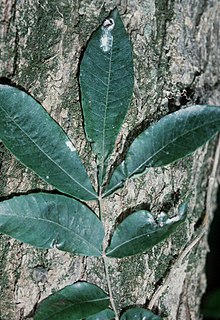Carya aquatica
| Water hickory | |
|---|---|
 |
|
| Bitternut Hickory foliage | |
| Scientific classification | |
| Kingdom: | Plantae |
| (unranked): | Angiosperms |
| (unranked): | Eudicots |
| (unranked): | Rosids |
| Order: | Fagales |
| Family: | Juglandaceae |
| Genus: | Carya |
| Species: | C. aquatica |
| Binomial name | |
|
Carya aquatica (F.Michx.) Nutt. |
|
 |
|
| Natural range of Carya aquatica | |
Carya aquatica (bitter pecan or water hickory) is a large tree, that can grow over 30 metres (98 ft) tall of the Juglandaceae or walnut family. In the American South it is a dominant plant species found on clay flats and backwater areas near streams and rivers. The species reproduces aggressively both by seed and sprouts from roots and from stumps of cut trees. Water hickory is a major component of wetland forests now in the south eastern US, because of the selective cutting of more desirable tree species for the lumber industry. It is considered important in cleansing drainage waters since the plants slow water flow during flooding, allowing sediments to fall out of the water column. This tree species is tolerant of wet soils but grows best on well draining soils near rivers and other water ways.
Water hickory inhabits the Atlantic and Gulf Coastal Plains from southeastern Virginia to southern Florida, Alabama, west into eastern Texas, and the Mississippi Valley north to southern Illinois.
Water hickory attains its best growth on moist but well-drained loamy or silty soils in the Mississippi River Valley and along some Coastal Plain streams. However, because of its slow growth rate and past logging and land management practices, it is rare on these sites except where it has been favored by repeated "high-grade" logging. Water hickory is now most often found on wet sites where only a few other species of trees grow, it is somewhat intolerant of competition being shade intolerant. It is common on clay flats, sloughs, and backwater areas, but seldom in coastal swamps or sites where soils are continually saturated. The species is most common on soils in the Vertic Haplaquepts subgroup of the order Inceptisols. Water hickory sites are subject to inundation during heavy rains and stream overflow, during droughts these sites dry out and develop cracking of the soil during occasional dry summers.
Water hickory is a major component of two forest cover types: Sugarberry-American Elm-Green Ash (Society of American Foresters Type 93) and Overcup Oak-Water Hickory (Type 96). It is a minor component in Sweetgurn-Willow Oak (Type 92) and is sometimes found on the edge of Baldcypress (Type 101) and Baldcypress-Tupelo (Type 102).
Important associated tree species are Quercus lyrata - Overcup oak, Quercus nuttallii - Nuttall oak, and Quercus phellos - Willow oaks; Ulmus crassifolia - Ceder elm and Ulmus americana - American elm; waterlocust and honeylocust (Gleditsia aquatica and G. triacanthos); pecan; green ash (Fraxinus pennsylvanica); sugarberry (Celtis laevigata); persimmon (Diospyros virginiana); red maple (Acer rubrum); and baldcypress (Taxodium distichum).
...
Wikipedia
